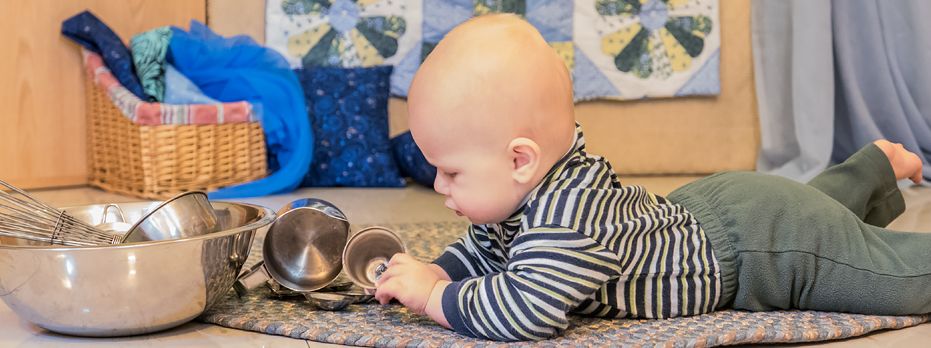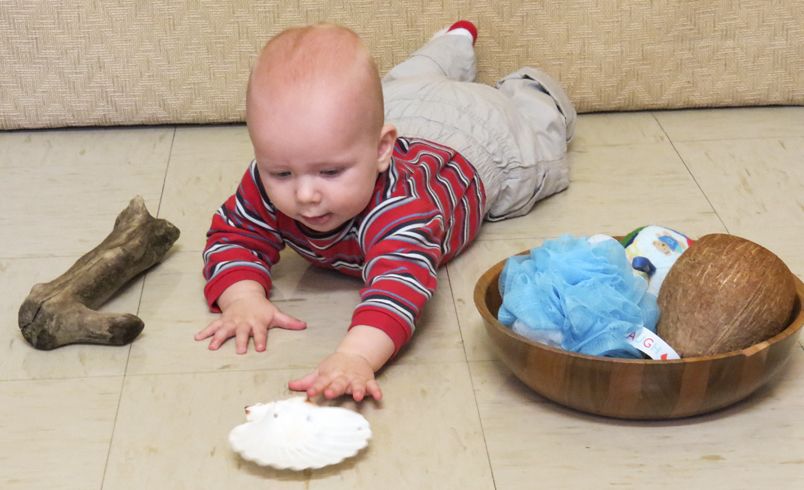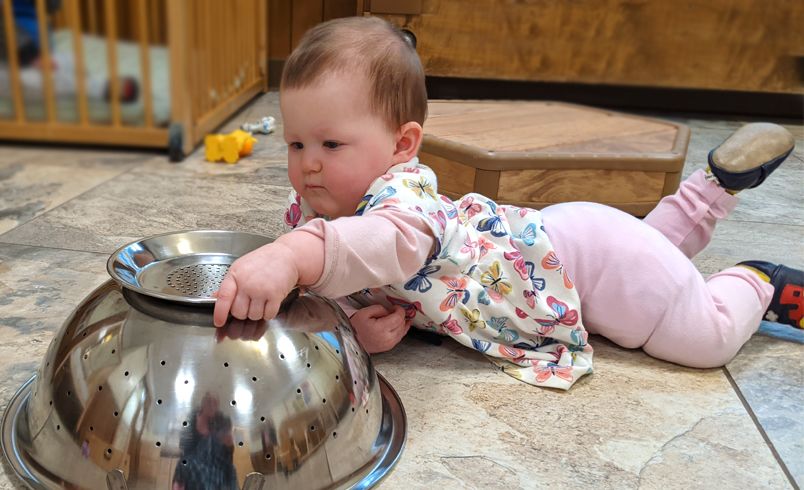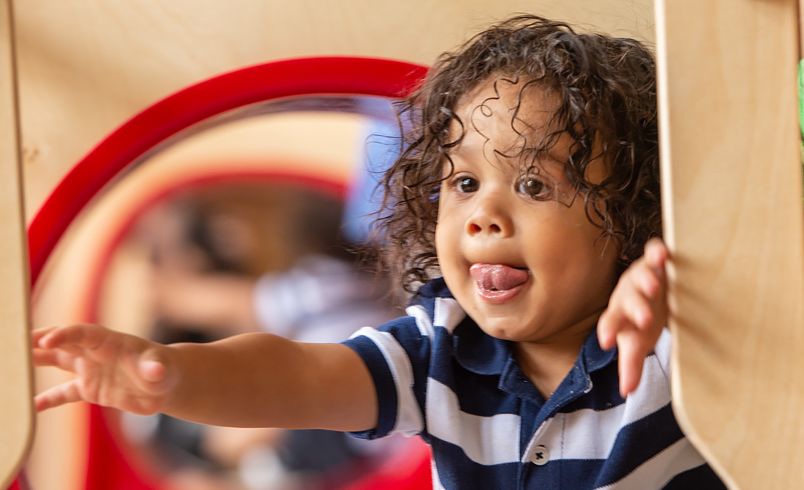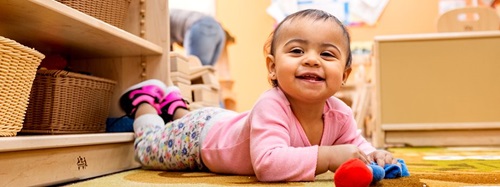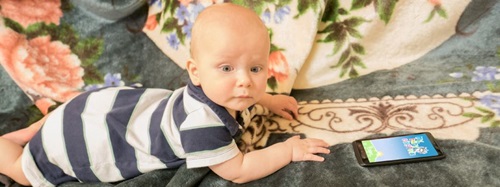Rethinking Infant Curriculum: Part 2
Observing, Documenting, and Interpreting: Where Infant-Toddler Teaching Begins
| February 2021Infants are quite intentional in their actions and in their play. When we linger to watch their play closely, they reveal to us, through gestures, expressions, and actions, their intentions, feelings, and ideas. Observing for cues as to what they might be thinking and then interpreting what it means is where teaching and learning with infants and toddlers begin.
Observing
Observing mindfully is distinct from being actively engaged with a child in play, talking with them about the play, or directing the play. Whether for 1 minute or 20 minutes, it means noticing with attention and care what unfolds. Esteemed baby-watcher and infant specialist Magda Gerber described this as (2002):
Let go of all the other issues that wander through your mind and really pay attention. Focus fully on everything your child does, trying to understand her point of view. Try to observe what interests her, how she handles frustration, solves little problems. Infants do not yet speak our language but they give us many, many signs. (p. 6)
When we are mindfully present as we observe infants’ play, we witness a nonverbal narration of intentions, assumptions, and experiments. We see them gather information with focused attention. Through movements, gestures, and expressions, we witness how they make predictions and generate theories about how objects relate or how people behave. An infant who shakes a rattle reveals an assumption, that this action will likely produce a sound. Very often it does, but sometimes it does not. Infants notice such differences, and as they notice differences, they build the important concept of classification, “This is just like (or not like) that.”
It is a rewarding experience to watch this process in action. As they play, infants peer at, mouth, finger, and shake objects, investigating what objects or people are like and how they react when acted upon in a particular way. A stare means “I’m interested,” but an averted gaze means, “I’ve had too much.” They gesture in ways that relay thoughts and intentions, “I want that,” or “Move away.” They compare what they find in one object or person with what they find in another. In doing so, they come to know the physical properties of objects and the features and behavior of people.
Infants pose silent questions, “So what does this feel like, look like, and act like? And what can I make it do? What will happen if I act on it like this?” These questions are hypotheses, much like those used by scientists as they investigate (Gopnik, 2009). An infant’s hypothesis, if exploring a rattle, might be, “If I shake this, I think it will make a sound.” Infants pose hypotheses, test them out in play, and make assumptions about how things work, how people respond, and why things happen, assumptions that over time are used to construct theories.
Infants spend their waking hours making meaning, that is, figuring out what things are like, what they do, or how they relate. Within simple moments of play or interaction with others, infants experiment, invent, and construct knowledge. They invite us—those who provide their care—to notice their play and to support them in their experiments. By observing infants’ play, we discover how we might support their learning, what Rinaldi (Lally & Mangione, 2006) describes as “possibilities for helping [infants] go deeper in their research.” Rinaldi (2006) explains this as follows:
We as teachers are asked by children to see them as scientists or philosophers searching to understand something, to draw out a meaning. . . . We are asked to be the child’s traveling companion in this search for meaning. We are also asked to respect the meanings that children produce, the explanatory theories they develop, and their attempts to find and give answers. When we honor the children this way, the children reveal themselves to us. We come to know how they perceive, question, and interpret reality, and to understand their relationships with it. (p. 21)
Documentation
Teachers and families join infants on a journey in which they are actively getting to know the world. Infants are active participants in charting the course of this journey, but to truly invite their participation, we need to watch and listen closely to their play and interactions. Once we observe with care, we hold what we notice in memory by documenting it in some way, in order to share it with others.
Rinaldi (1994) explains that young children “ask us to listen, to observe, and support them; and to render them visible” (p. 59). By rendering them visible, she means carefully documenting significant parts of what they do or say, through notes or photos. Such documentation makes it possible for teachers and families to read, reflect on, and think together about what might be children’s ideas, intentions, or feelings within an episode of play or an interaction. The value of a written note or a photo is that it holds traces of what children do or say, evidence of children’s ideas and thoughts. This evidence, preserved as documentation, is easily shared with others and mined for ideas on how to best support children’s learning.
The following illustrates a clear, vivid description of what occurred in a moment of play:
Observation:
Catalina crawls toward a small metal colander, grabs the curved edge, tips it onto the side, and peers at the interior laced with tiny holes. She picks it up, rotates to the side, and mouths the curved edge, waving the colander back and forth before dropping it. It lands upright and wobbles on its circular bottom. She watches it rotate, carving a circle before slowing to a stop. Eyes glued to the colander, she pats the edge, watching it wobble in a circle again before slowly coming to a stop.
A written record like this note is one form of documentation. Another is a photo or video capturing expressions, gestures, timing, or movements, all of which can be significant in relaying a child’s idea or intention.
Reflecting and Interpreting
When written observations and photos are rich in detail, they hold in memory and communicate to those who were not present a clear description of what was seen or heard so that it can be shared and interpreted later with others. When we interpret an event, we suggest possibilities for what the child might be intending, feeling, or thinking. For example, “I think he wanted to . . . ,” or, “Perhaps he was frustrated because . . . .” We reflect on and try to learn from what the child did or said. This is not always easy, yet clear and vivid documentation generates a wealth of questions and reflections that lead to thoughtful interpretation.
The following note shows how baby Catalina’s teacher recorded her interpretation of the observed play.
Interpretation:
Catalina appears to be gathering information about the round container. She then experiments with what she can make it do—acting on it and watching it react. She tests to see whether she can repeat an action. It is as if she asks, “So what happens when I push down on the edge? It wobbles back and forth! Can I make it happen again?” She is constructing a relationship of cause and effect. She appears to have an idea, “If I drop this round object or even just slap the edge, I can make it move in an interesting way.”
When adults review and interpret together documentation of play, they engage in a reflective dialogue, sharing ideas. Reflective dialogue is an effective way for teachers to invite families to join them in support of children’s learning, exchanging impressions and ideas about what children are thinking and exploring possibilities for what contexts to prepare next to help children go deeper in their research.
Reflective Planning
When we observe, document, and interpret mindfully, we collaborate with infants and toddlers in navigating their journey of discovery. We respect their role in the process of planning and implementing “curriculum.” When we observe, document, and interpret infants’ play and interactions, we launch a reflective cycle of teaching and learning (California Department of Education, 2012). We observe and reflect, we document and reflect, we interpret and plan new contexts for infants, and once we do so, the cycle begins anew, as we observe to discover what they do in response.
Reflective Planning Cycle
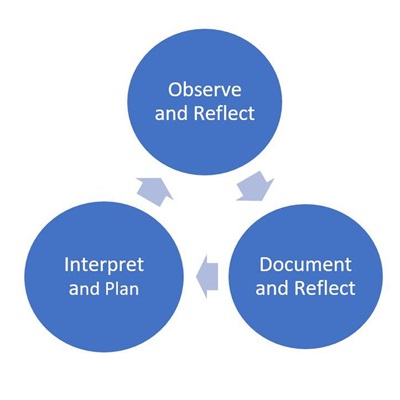
This article is adapted from Teaching and learning with infants and toddlers: Where meaning-making begins, 2nd edition, published in 2020 by Teachers College Press.
References:
California Department of Education. (2012). California Infant-toddler curriculum framework. Sacramento, CA: Author.
Gerber, M. (2002). Dear parent: Caring for infants with respect. (J. Weaver, Ed., 2nd ed.). Los Angeles, CA: Resources for Infant Educarers.
Gopnik, A. (2009). The philosophical baby. What children’s minds tell us about truth, love, and the meaning of life. New York, NY: Farrar, Straus and Giroux.
Lally, J. R. (Executive Producer/Content Developer/Writer), Mangione, P. L. (Content Developer/Writer), Greenwald, D. (Content Developer/Writer/Producer), Butterfield, G.O. (Content Developer/Writer/Producer/Editor), & Signer, S. (Content Developer/Writer). (2006). New perspectives on infant-toddler learning, development, and care. [DVD]. United States: California Department of Education.
Rinaldi, C. (2006). Creativity, shared meaning, and relationships. In J. R. Lally, P. L. Mangione, & D. Greenwald (Eds.), Concepts for care: 20 essays on infant/toddler development and learning (pp. 21-23). San Francisco, CA: WestEd.
Rinaldi, C. (1994). Staff development in Reggio Emilia. In L. Katz & B. Cesarone (Eds.), Reflections on the Reggio Emilia approach (Perspectives from ERIC/EECE, a Monograph Series, No. 6, pp. 55-59). Urbana, IL: ERIC Clearinghouse on Elementary and Early Childhood Education.

